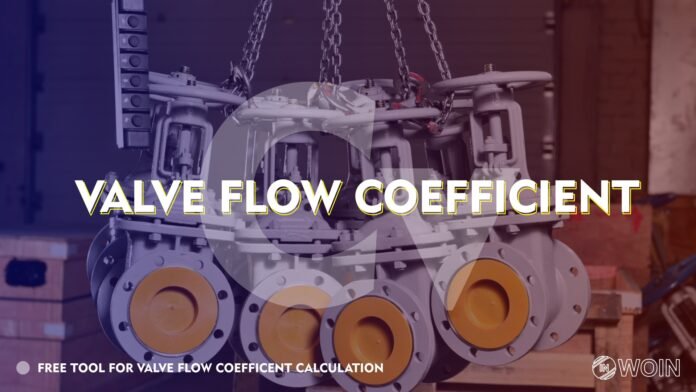The valve flow coefficient is a very important parameter for the proper selection of any type of valve for industrial applications. In this article, you will learn all about the Valve flow Coefficient (Cv) | Free tool for Cv calculations.
In this article, I also share a free tool for the calculation of valve flow coefficient as per process requirements.
Introduction
The control valve flow coefficient or Cv is the number of US gallons per minute (1 US gallon is 3.786 liter) of water that passes through a given area with a pressure drop of 1 PSI.
Although the standard definition mentions water as a fluid, this will remain the same for other fluids and gases also.
Let us understand this standard definition with the help of an example. Suppose a given valve has a valve flow coefficient (Cv) of 1, it will allow 1 U.S. gallon per minute (GPM) of water through the valve with a pressure drop of 1 PSI.
The specific gravity also plays a very important role in defining this valve flow coefficient (Cv). This is the reason why we consider specific gravity in the calculation of the valve flow coefficient (Cv).
But what if we change some parameters like gallons per minute? What will be the impact? If we require 5 gallons per minute with all other conditions the same, then simply valve flow coefficient (Cv) will change to 5.
Now let us know how to calculate the valve flow coefficient (Cv) for any other given fluid/liquid/gas.
How do we calculate the valve flow coefficient (Cv)?
3 main parameters need to be known before calculating valve flow coefficient (Cv)
1. Specific Gravity (SG)
You all might be aware of the term specific gravity. Specific gravity is the density ratio of any given fluid/liquid/gas with that of water at 4 degrees Centigrade.
Example:
Water = 1
Ethanol = 0.78
Iron = 7.87
Gold = 19.3
2. Flow Rate (Q)
Flow rate can be simply known as it is a readily available parameter. Flow rate is taken in gallons per minute. If it is in some other, you need to convert it into gallons per minute.
3. Pressure Drop (P)
Pressure drop is the most critical and complex parameter required for valve flow coefficient. It also changes with change in the material of construction of the pipe as it induces friction to the flow.
Another parameter like temperature also has an impact on the pressure drop. Because as temperature changes, density changes and it makes a change in pressure of the fluid/liquid/gas. A pressure drop is needed in the psi unit.
Now we saw what are the 3 parameters needed for calculating the valve flow coefficient.
Let us see how to calculate the valve flow coefficient using specific gravity, flow rate, and pressure drop.
The first step is gathering all 3 parameter values and changing them to the units we discussed.
The formula needed is Cv = Q * (√ (SG/P)).
How to Calculate Cv?
Suppose we take a liquid (water) with a specific gravity of 1. The rate of flow needed is 20 gallons per minute. And the pressure drop requirement is 0.15.
Now plugging these 3 parameters into the equation.
- Cv = Q * (√ (SG/P))
- = 20 * (√ (1/0.15))
- = 20 * (√ (6.6667))
- = 20 * 2.58198
- Cv = 51.6397
So, you need to select a valve with a valve flow coefficient of 51.6397 to achieve 20 gallons per minute of flow at 0.15 psi for water.
Now can you calculate the valve flow coefficient for the given parameters?
1) Q = 0.6814, SG = 3, P = 3 (Answer = 30)
2) Q = 8, SG = 0.1, P = 0.85 (Answer = 6.99)
Free Tool for Calculating Valve Cv
Kimrey Provides a free online tool to calculate control valve Cv and Control valve flow rate as per Valve Cv.
By Clicking on the button below, you will be directly redirected to Kimray’s Website where you can find the control valve Cv calculation page.

Calculate Valve CV
Here is a video tutorial guide for how to calculate control valve Cv by using this tool.
EndNote
I hope now you have a complete idea about the control valve flow coefficient Cv. This article is very important because the control valve flow coefficient is a very important factor for control valve selection.
If you have any minor doubts on this topic, I will recommend you to watch this Kimray’s video on control valve flow coefficient to visually understand the topic.
If you have any questions please comment below and stay connected for future articles on instrumentation and automation to build strong fundamentals on it.


